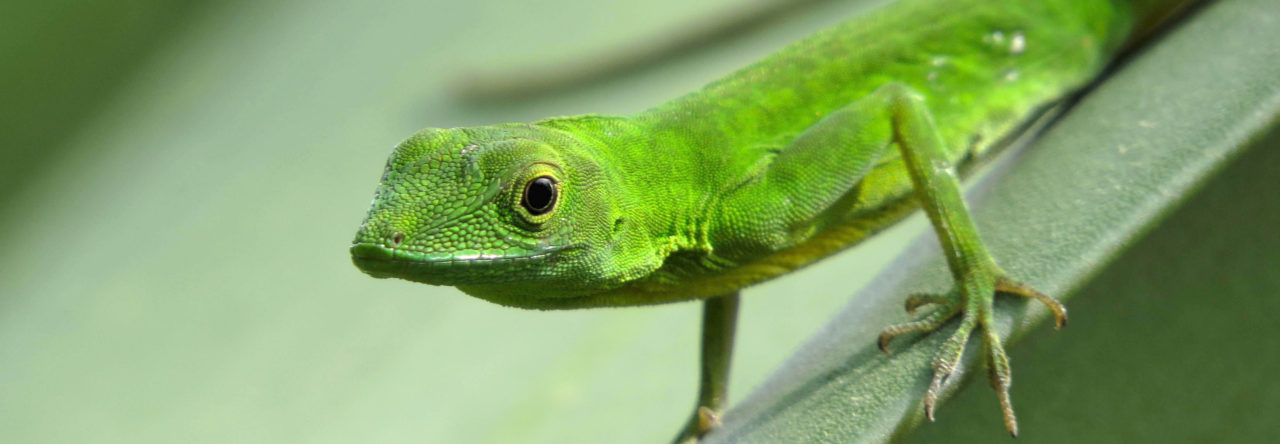
I saw the recent posts about orange/red sagrei and I thought I might contribute another observation of orange-colored brown anoles. A few years ago while assisting another grad student with his dissertation work I spotted a few orange-colored brown anoles in a suburban yard in S. Florida. What I thought was most interesting about the observation was that: 1) there were multiple males (2-3) with orange color, and 2) many of the palms on which lizards were perched were a similar orange color. It got me thinking that it could be more than a coincidence.
The orange color on the trees, sidewalks, and other hard substrates in the area is from ground water with a high concentration of iron. When sprayed on the surface with sprinklers it mixes with oxygen and leaves an orange color. Many houses, signs, sidewalks, and even cars in S. Florida are graced with an arc or two of orange residue. I’ve yet to revisit this lawn or surrounding houses, but I bet there are quite a few more houses with orange lizards. For what it’s worth, I see and catch a lot of brown anoles further south in the Miami area and this is the only case of red/orange brown anoles I’ve seen yet. It’s possible that these lizards were covered in rust, but it didn’t look like it when I got one in my hand. It’s also interesting that all of the photos I’ve seen of orange-colored brown anoles are male, however I’ve only seen about 4 cases including this observation. Oh, and the dewlaps on these males were normal(ish), not like the cool one recently posted by Joe Burgess.
- Knight Anoles Eat Fruit and Pass Viable Seeds - June 21, 2017
- Winter Activity in North Carolina Green Anoles - February 1, 2015
- Are Bark Anoles (Anolis distichus) Native to Abaco Island, Bahamas? - January 23, 2014


bella
Very interesting, though the lizards may be covered in rust…are they at all harmed?
bellab87
Maybe the sex of the unhatched eggs are determined by the iron concentration on the environment.
kimberly
I saw an orange anole of this type today in Ft. Lauderdale by my office building. It was the first I’ve ever seen of this color in the area. The location is just off of the Cypress Creek exit (West) from 95 southbound in case you were interested. As you noted the anole didn’t seem to be covered in rust, but had rusty-orange colored skin. Perhaps a local environmental adaptation?
Farrell Tyson
I live in SW FL for several years and have only had brown anoles and few green ones. This past year we have had a population explosion of red/orange anoles. Both male and female are colored as such. They really stand out in the garden. We do not have the high iron content in our sprinkler water here.
B.
It would appear we have ourselves a new color morph; I have a couple of really good shots of an orange Anolis sagrei as well. These are definitely not ferrous-influenced colors either.
From Sunrise, Florida.
Threw it on photobucket…
http://i1213.photobucket.com/albums/cc471/OrangeSagrei/Orange.jpg
Evi Paemelaere
Very interesting! I’ve seen N. limifrons females where the cream stripe turns orange, and back to cream. Would be really interesting to look into the mechanism.
DJ
While I have only seen 3 total ever. I just caught two and plan to transplant them to my new house in hopes of getting the genes in the mix there. One is a male I have been observing a couple years, and the other a female I am pretty sure is last years offspring of the same male. Seems like they are spread all over judging by posts. SW Fla, multiple there, in Broward, Miami and up by Payne’s Prairie. I guess we will be seeing more of them. Never saw one growing up till seeing the first about 8 years ago here in North East Broward. Anyone know what the genetics would be? Double recessive? You know how once in a while you will see a large male that is a uniform light tan with no other markings? They often have a pronounced dorsal crest, too. Well the male is uniform in color the same way but has the rust/copper/orange color trait. Double recessive? I’d be interested in hearing opinions. Thanks. I plan on getting the local kids to rustle some up for me if they can and transplant multiple examples to my property. They are very pretty little guys.
Dick
Hi there, saw your blog and here is “ours ” in the front yard and for those interested we’re in WPB, wonderful looking one.
Jorge Martinez
Hi everyone. Dont have any pictures, but I have at least one of these rust orange male anoles running about the foliage in front of my apartment in west palm beach. I had never seen one of this color in 30 years living in south florida. Curious to see they are turning up all over now.